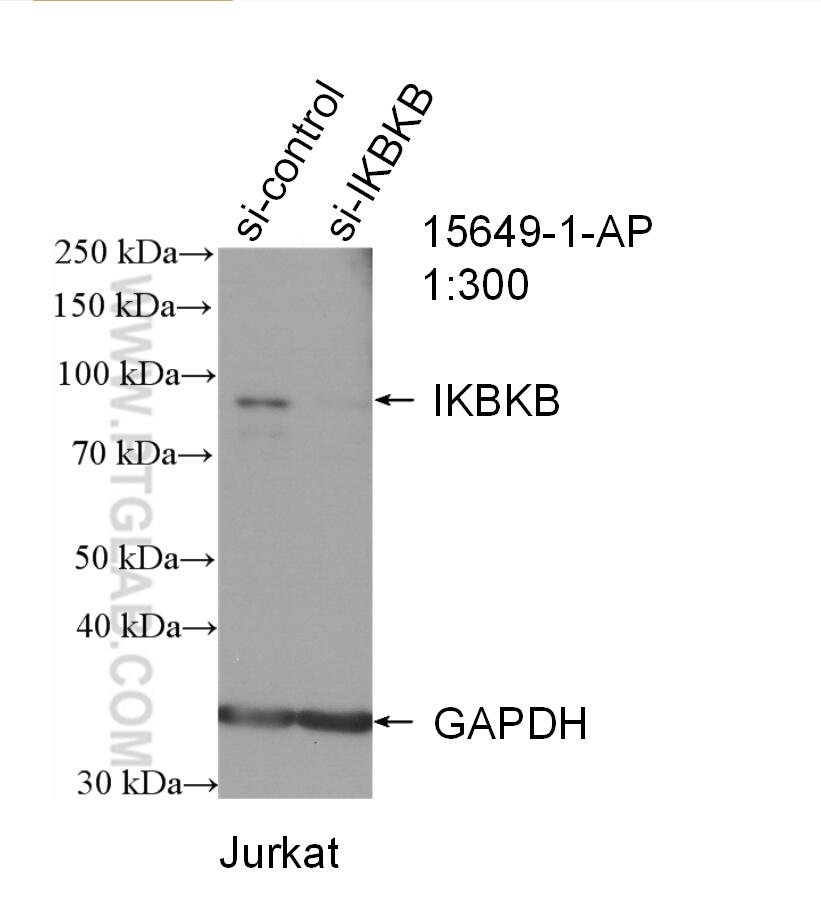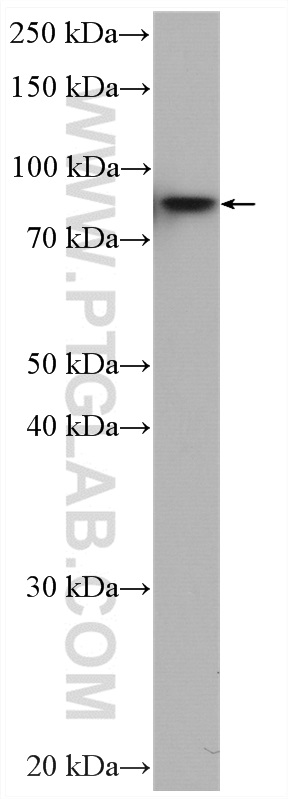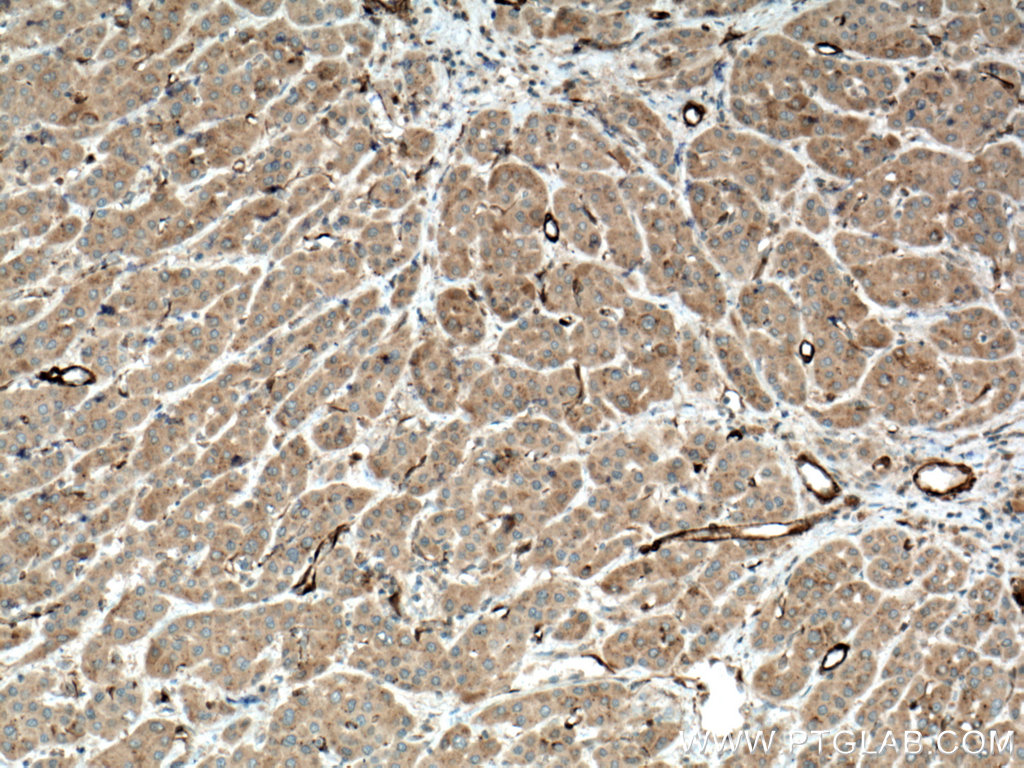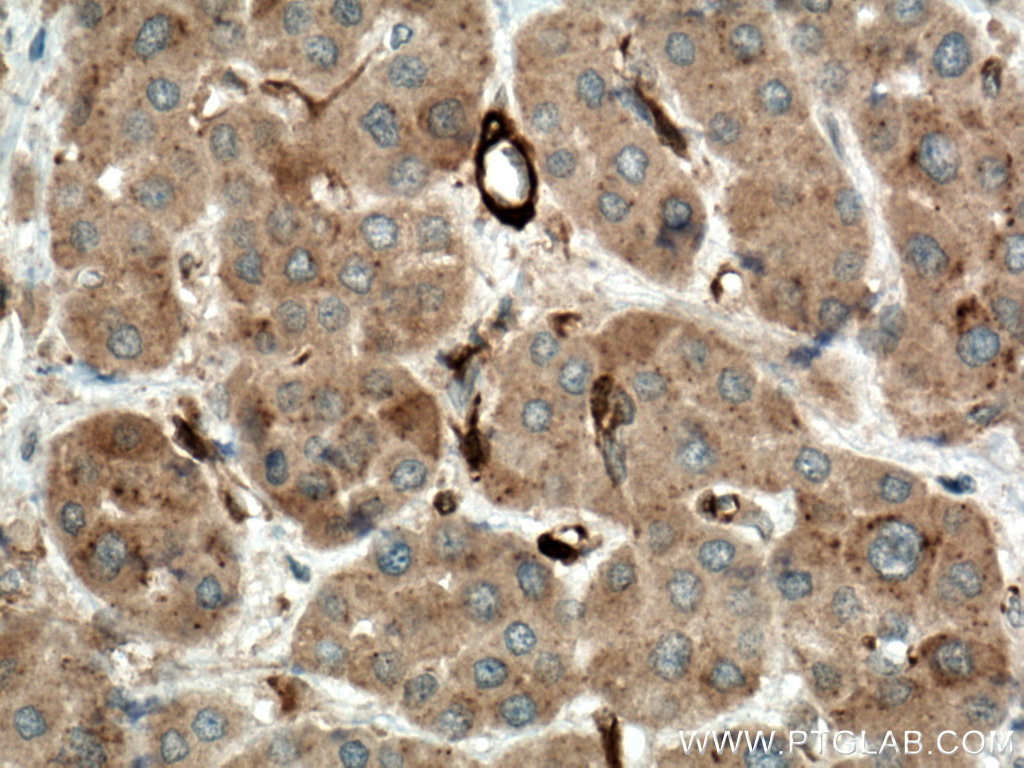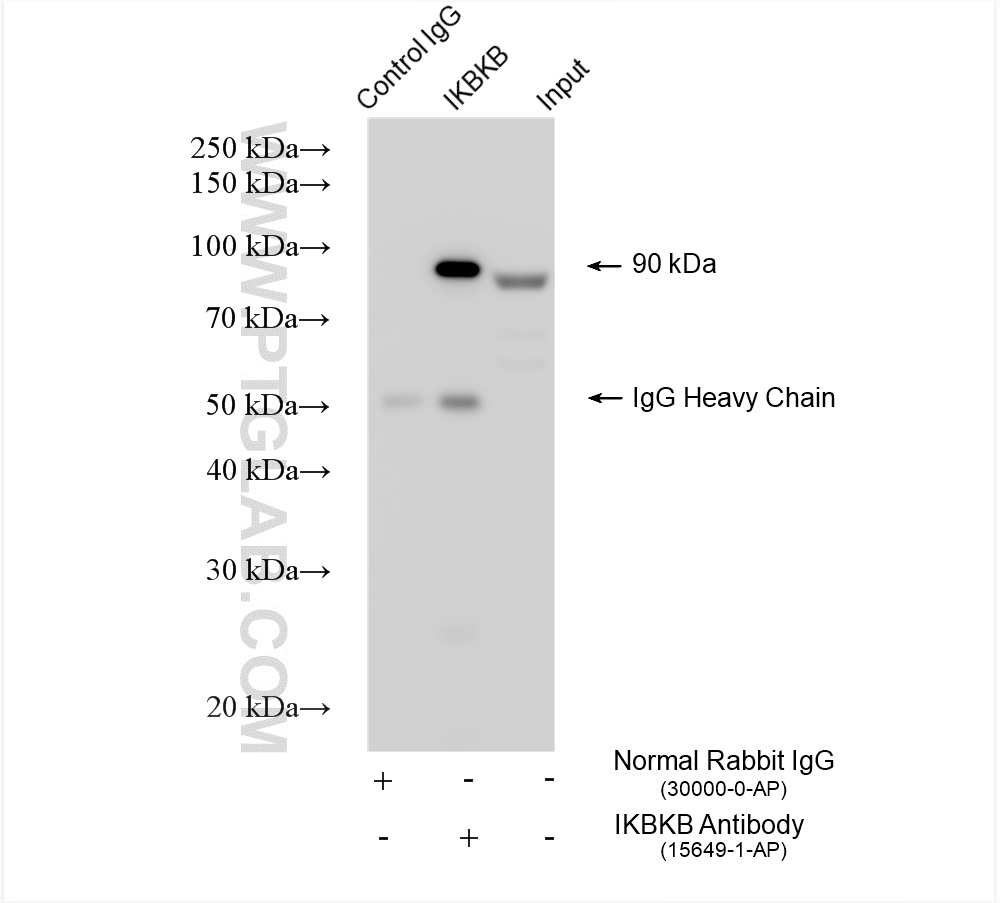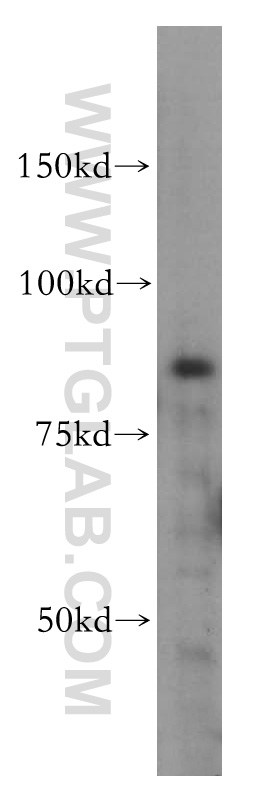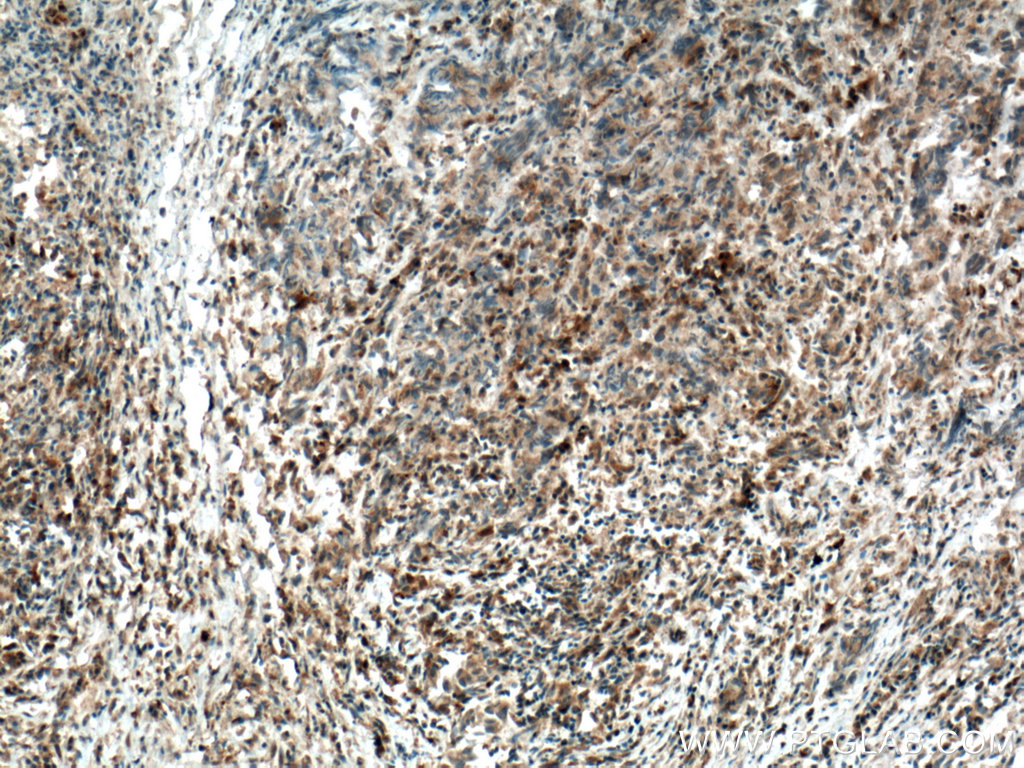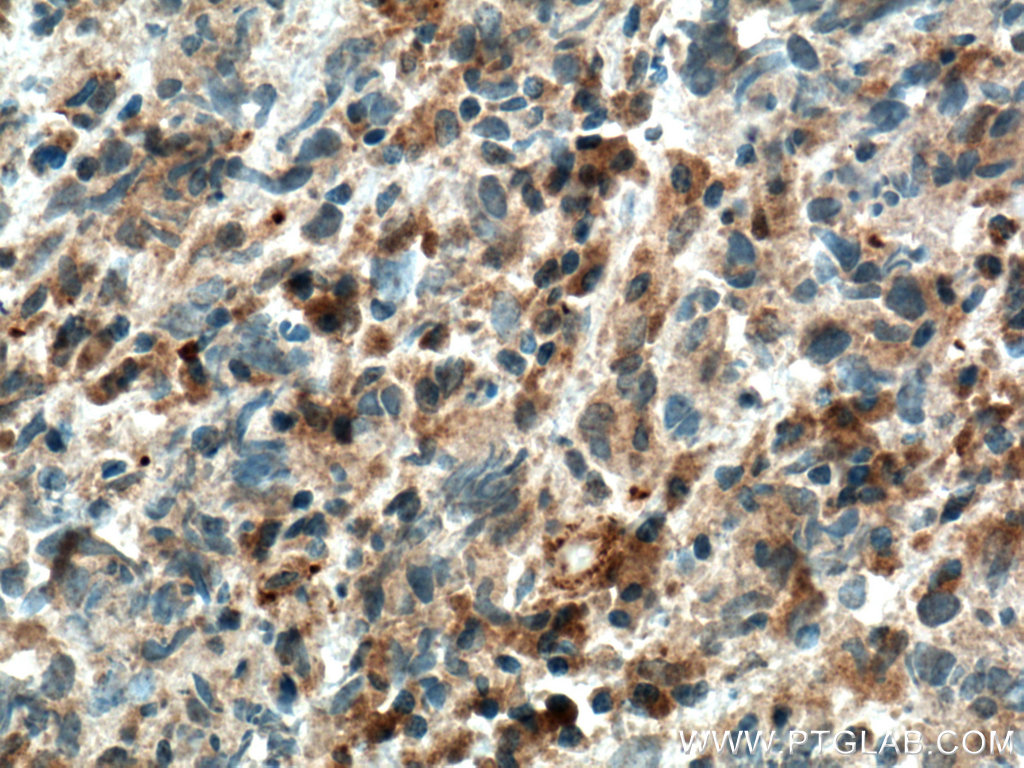验证数据展示
经过测试的应用
| Positive WB detected in | Jurkat cells, K-562 cells, HepG2 cells |
| Positive IP detected in | Jurkat cells |
| Positive IHC detected in | human liver cancer tissue, human prostate cancer tissue Note: suggested antigen retrieval with TE buffer pH 9.0; (*) Alternatively, antigen retrieval may be performed with citrate buffer pH 6.0 |
推荐稀释比
| Application | Dilution |
|---|---|
| Western Blot (WB) | WB : 1:300-1:1000 |
| Immunoprecipitation (IP) | IP : 0.5-4.0 ug for 1.0-3.0 mg of total protein lysate |
| Immunohistochemistry (IHC) | IHC : 1:50-1:500 |
| It is recommended that this reagent should be titrated in each testing system to obtain optimal results. | |
| Sample-dependent, Check data in validation data gallery. | |
产品信息
15649-1-AP targets IKBKB in WB, IHC, IF, IP, CoIP, ELISA applications and shows reactivity with human, mouse, rat samples.
| Tested Applications | WB, IP, IHC, ELISA Application Description |
| Cited Applications | WB, IHC, IF, IP, CoIP |
| Tested Reactivity | human, mouse, rat |
| Cited Reactivity | human, mouse, rat, bovine |
| Immunogen | IKBKB fusion protein Ag8191 种属同源性预测 |
| Host / Isotype | Rabbit / IgG |
| Class | Polyclonal |
| Type | Antibody |
| Full Name | inhibitor of kappa light polypeptide gene enhancer in B-cells, kinase beta |
| Synonyms | I kappa B kinase 2, I kappa B kinase beta, IKBKB, IKK B, IKK beta, IKK2, IKKB, IκB, NFKBIKB |
| Calculated Molecular Weight | 756aa,81 kDa; 256aa,29 kDa |
| Observed Molecular Weight | 80 kDa, 86 kDa, 87 and 29 kDa |
| GenBank Accession Number | BC006231 |
| Gene Symbol | IKBKB |
| Gene ID (NCBI) | 3551 |
| RRID | AB_2122307 |
| Conjugate | Unconjugated |
| Form | Liquid |
| Purification Method | Antigen affinity purification |
| UNIPROT ID | O14920 |
| Storage Buffer | PBS with 0.02% sodium azide and 50% glycerol pH 7.3. |
| Storage Conditions | Store at -20°C. Stable for one year after shipment. Aliquoting is unnecessary for -20oC storage. |
背景介绍
IKBKB, also named as IKKB, IKK2, NFKBIKB and IKK-B, belongs to the protein kinase superfamily, Ser/Thr protein kinase family and I-kappa-B kinase subfamily. IKBKB is a Serine kinase that plays an essential role in the NF-kappa-B signaling pathway. It acts as part of the canonical IKK complex in the conventional pathway of NF-kappa-B activation and phosphorylates inhibitors of NF-kappa-B on 2 critical serine residues. In addition to the NF-kappa-B inhibitors, IKBKB phosphorylates several other components of the signaling pathway including NEMO/IKBKG, NF-kappa-B subunits RELA and NFKB1, as well as IKK-related kinases TBK1 and IKBKE. It also phosphorylates other substrates including NCOA3, BCL10 and IRS1. Within the nucleus, IKBKB acts as an adapter protein for NFKBIA degradation in UV-induced NF-kappa-B activation. This antibody can identify 4 isoform of IKBKB with the molecular weight of 80, 86, 87 and 29 kDa.
实验方案
| Product Specific Protocols | |
|---|---|
| WB protocol for IKBKB antibody 15649-1-AP | Download protocol |
| IHC protocol for IKBKB antibody 15649-1-AP | Download protocol |
| IP protocol for IKBKB antibody 15649-1-AP | Download protocol |
| Standard Protocols | |
|---|---|
| Click here to view our Standard Protocols |
发表文章
| Species | Application | Title |
|---|---|---|
Nat Commun Hypothalamic SLC7A14 accounts for aging-reduced lipolysis in white adipose tissue of male mice | ||
Adv Sci (Weinh) Sirtuin 5-Mediated Desuccinylation of ALDH2 Alleviates Mitochondrial Oxidative Stress Following Acetaminophen-Induced Acute Liver Injury | ||
Drug Des Devel Ther Sichen Formula Ameliorates Lipopolysaccharide-Induced Acute Lung Injury via Blocking the TLR4 Signaling Pathways | ||
Cell Death Discov tRNA-derived fragment TRF365 regulates the metabolism of anterior cruciate ligament cells by targeting IKBKB. | ||
Redox Biol Cardioprotection of CAPE-oNO2 against myocardial ischemia/reperfusion induced ROS generation via regulating the SIRT1/eNOS/NF-κB pathway in vivo and in vitro. | ||
